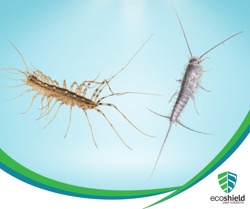As a homeowner, chances are you've encountered your fair share of creepy crawlies in the corners of your home. Two of the most common and often misunderstood pests are house centipedes and silverfish. While they may share a penchant for surprising us in our own homes, these bugs have several distinct characteristics, behaviors, and impacts on our homes. Join us as we delve into the intriguing world of house centipedes and silverfish, examining their similarities and differences, and equipping you with the knowledge you need to identify, manage, and prevent these unwelcome guests.
What are House Centipedes?
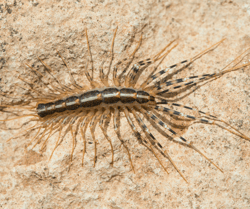 House centipedes, scientifically known as Scutigera coleoptrata, are peculiar and often unwelcome arthropods that frequently find their way into the darkest corners of homes. These creatures are not true insects but belong to the class Chilopoda within the subphylum Myriapoda, making them very close relatives of millipedes. House centipedes are identified by their elongated, flattened bodies, typically ranging from 1 to 1.5 inches in length, and their many legs, which can range from 15 to 177 pairs, depending on their age and species.
House centipedes, scientifically known as Scutigera coleoptrata, are peculiar and often unwelcome arthropods that frequently find their way into the darkest corners of homes. These creatures are not true insects but belong to the class Chilopoda within the subphylum Myriapoda, making them very close relatives of millipedes. House centipedes are identified by their elongated, flattened bodies, typically ranging from 1 to 1.5 inches in length, and their many legs, which can range from 15 to 177 pairs, depending on their age and species.
One of the most distinctive features of house centipedes is their ability to move rapidly, facilitated by their numerous legs. They scuttle with shocking speed, making them appear almost like a blur when they dart across your floors. Their name, "centipede," is derived from the Latin words "centum" (meaning hundred) and "ped" (meaning foot). Their name is somewhat of a misnomer as centipedes don’t have exactly 100 legs - in fact, you’ll never spot a 100-legged centipede as they only ever have an odd number of pairs of legs.
Many homeowners are unaware that house centipedes are skilled predators. Their diet primarily consists of insects and other small arthropods, including spiders, silverfish, and cockroach nymphs (immature cockroaches). They possess highly specialized, venomous fangs, which they use to immobilize their prey expertly. Unsurprisingly, a house centipede’s presence can be unsettling to many homeowners due to its alarming appearance and abrupt, unexpected movement and speed.
What are Silverfish?
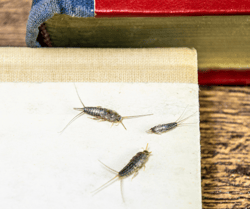 Silverfish, scientifically known as Lepisma saccharina, are unique and ancient insects that have inhabited the Earth for hundreds of millions of years – seriously! These small, wingless creatures are aptly named for their fish-like, teardrop-shaped bodies covered in silvery-gray scales. Relatively small, silverfish typically measure between ½ to 1 inch in length and possess a distinct, tapered appearance. They’re also equipped with three long tail-like appendages known as cerci extending from the rear of their bodies, which are primarily used for detecting vibrations and navigating the world around them.
Silverfish, scientifically known as Lepisma saccharina, are unique and ancient insects that have inhabited the Earth for hundreds of millions of years – seriously! These small, wingless creatures are aptly named for their fish-like, teardrop-shaped bodies covered in silvery-gray scales. Relatively small, silverfish typically measure between ½ to 1 inch in length and possess a distinct, tapered appearance. They’re also equipped with three long tail-like appendages known as cerci extending from the rear of their bodies, which are primarily used for detecting vibrations and navigating the world around them.
Silverfish are particularly well-adapted to thrive in dark, damp, and secluded environments, making them often unwelcome guests in homes, basements, and bathrooms. They are nocturnal creatures, preferring to emerge during the nighttime hours when they forage for food undisturbed. Silverfish are both agile and fast-moving, using their slender bodies to navigate through cracks and crevices in search of sustenance.
These insects are omnivorous scavengers with a voracious appetite for starchy substances. They feed on various materials commonly found in homes, including paper, cardboard, glue, book bindings, and occasionally even clothing. This diet includes items like old books, wallpaper, and stored grains, which can make them a nuisance when they infest pantries and storage areas like the basement. While silverfish are not harmful to human health, their presence can be problematic when they damage cherished items or important documents due to their feeding habits.
Key Differences Between Silverfish and House Centipedes
House centipedes and silverfish are two distinct types of household pests with several key differences.
- Physical Appearance:
House Centipedes: They have elongated, flattened bodies with numerous legs, ranging from 15 to 177 pairs, depending on their age and species. House centipedes are typically brownish or grayish in color.
Silverfish: Silverfish have teardrop-shaped bodies covered in silvery-gray scales. They have a distinctive appearance, with three long tail-like appendages extending from their rear.
- Legs:
House Centipedes: They are known for their many legs, which can be quite long, giving them the appearance of moving rapidly.
Silverfish: Silverfish have six legs, a typical characteristic of insects.
- Diet:
House Centipedes: They are carnivorous predators that primarily feed on insects, spiders, and other small arthropods.
Silverfish: Silverfish are omnivorous scavengers with a preference for starchy substances like paper, cardboard, glue, and stored grains.
- Habitat:
House Centipedes: They are often found in dark, damp, and secluded areas of the home, such as basements and bathrooms.
Silverfish: Silverfish also prefer dark and damp environments but are known to infest a wider range of household materials, including books, wallpaper, and clothing.
- Behavior:
House Centipedes: House centipedes are fast-moving and are more likely to be seen scurrying across floors or walls, especially at night.
Silverfish: Silverfish tend to move more slowly and are often found in hidden, sheltered places during the day.
- Beneficial vs. Nuisance:
House Centipedes: Despite their unsettling appearance, house centipedes are considered beneficial by some homeowners because they help control other pest populations.
Silverfish: Silverfish are generally considered a nuisance due to their potential to damage books, paper, and other household items.
Understanding these differences can help homeowners identify and manage infestations of these two distinct pests more effectively.
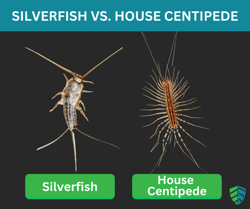
Key Similarities Between Silverfish and House Centipedes
While house centipedes and silverfish have several differences in terms of their appearance, behavior, and diet, there are a few key similarities:
- Preference for Dark and Damp Environments: Both house centipedes and silverfish are nocturnal creatures that prefer to inhabit dark, damp, and secluded areas. Basements, bathrooms, and crawlspaces are common places to find both pests.
- Nuisance Pests: Many homeowners consider both house centipedes and silverfish to be unwanted guests due to their presence in living spaces. Their sudden appearances can be startling, and they often evoke feelings of discomfort.
- Scavengers: While their primary diets differ, both pests are scavengers. House centipedes prey on insects and other small arthropods, while silverfish feed on starchy materials and can damage paper, cardboard, and other household items.
- Nocturnal Activity: House centipedes and silverfish are primarily active at night, which means they are often encountered by homeowners when they emerge from their hiding spots in search of food.
- Longevity: Both house centipedes and silverfish have relatively long lifespans for pests of their size. They can survive for several years under the right conditions.
- Potential for Infestations: While not as common as some other pests, both house centipedes and silverfish can infest homes when conditions are suitable. Homeowners may need to take measures to prevent or manage infestations of either pest.
It's important to note that despite these similarities, house centipedes and silverfish are distinct creatures with different habits, appearances, and ecological roles in the home. Understanding these differences is essential for effective pest management.
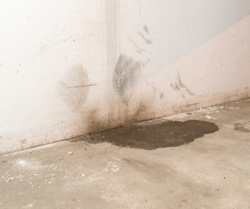 Silverfish and house centipedes both prefer dark, damp spaces like basements.
Silverfish and house centipedes both prefer dark, damp spaces like basements.
Can I prevent house centipedes and silverfish in my home?
Yes! Luckily, there are several preventive measures you can employ to reduce the likelihood of house centipedes and silverfish infesting your home. Prevention is the best first line of defense against infestations and can be a powerful tool in pest management. Here are some steps you can take to help prevent house centipedes and silverfish:
- Maintain Cleanliness:
Regularly clean and vacuum your home to remove crumbs, debris, and potential food sources for pests.
Pay close attention to dark and damp areas like basements, bathrooms, and kitchen cabinets.
- Reduce Moisture:
Repair any plumbing leaks promptly to eliminate sources of moisture that attract both house centipedes and silverfish.
Use dehumidifiers in damp areas of your home to reduce humidity levels.
- Seal Entry Points:
Inspect and seal cracks, gaps, and openings in your home's foundation, walls, windows, and doors to prevent pests from entering.
Repair damaged window and door screens.
- Remove Clutter:
Declutter storage areas to reduce hiding places for silverfish.
Store items in airtight containers to make them less accessible to silverfish and other pests.
- Store Food Securely:
Store food items in sealed containers, especially grains, cereals, and other pantry staples.
Clean up food spills and crumbs promptly.
- Eliminate Nesting Sites:
Remove piles of newspapers, magazines, and cardboard boxes, which can serve as harborage sites for silverfish.
Keep firewood, mulch, and organic debris away from your home's foundation to discourage both pests from hiding there.
- Reduce Exterior Lighting:
House centipedes are attracted to light sources. Consider using less exterior lighting or use yellow or sodium vapor bulbs, which are less attractive to insects.
- Regular Inspections:
A trusted pest professional should periodically inspect your home for signs of infestation, such as shed skins, droppings, or the pests themselves.
Address any issues promptly if you notice an infestation.
- Pest-Proofing:
To keep pests out, consider using pest-proofing materials like weatherstripping, door sweeps, and window screens.
- Professional Pest Control:
If you have a persistent or severe infestation or prefer a hands-off approach to pest control, it may be necessary to consult a professional pest control service to assess the situation and implement targeted treatments.
By implementing these preventive measures, you can significantly reduce the chances of house centipedes and silverfish taking up residence in your home. Remember that a proactive approach to pest control is often more effective than dealing with an established infestation.
 A trusted pest professional like EcoShield can help homeowners prevent and remove silverfish and centipedes.
A trusted pest professional like EcoShield can help homeowners prevent and remove silverfish and centipedes.
Can EcoShield Pest Solutions Prevent or Remove House Centipedes and Silverfish?
Yes! EcoShield offers year-round protection against a variety of common pests, including both house centipedes and silverfish. We highly recommend homeowners safeguard their homes against potentially damaging house centipede or silverfish infestations with a comprehensive pest prevention strategy like the Shield Home Protection Plan. To prevent or remove house centipedes and silverfish in your home, give EcoShield a call or fill out the form on this page today.
